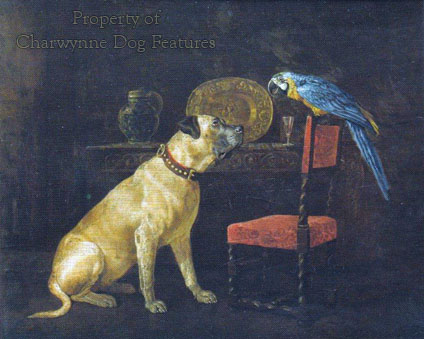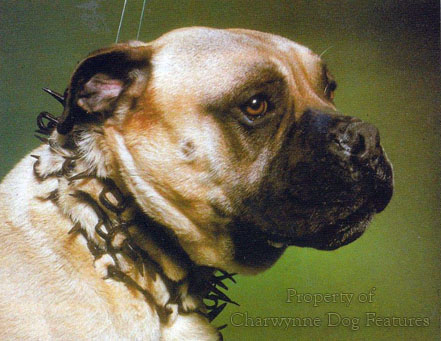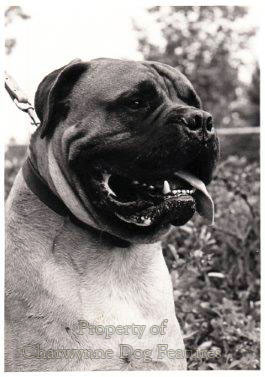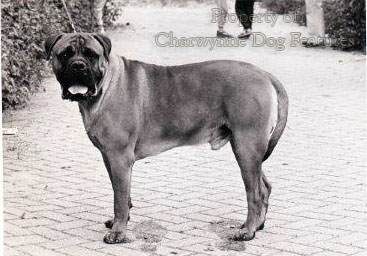236 Future of Bullmastiff
THE FUTURE OF THE BREED
by David Hancock
 Seeking Improvement
Seeking Improvement
If you judge the condition of the breed of Bullmastiff on the annual registration figures, the number of entries at championship shows and the membership of the six breed clubs or societies, then you could be forgiven for thinking that it is good. That is however not the collection of yardsticks on which to judge the health of any breed of pure-bred dog. Those familiar with the breed of German Shepherd Dog over the last fifty years will quickly confirm that numerical strength doesn't reflect the state of the breed. There will always be those, of course, who consider the best in any sphere to have been in the past. Such nostalgists however do not contribute much to the future. But true lovers of any breed of dog surely want to leave it in better shape than when they found it.
Threats to the Breed
Perhaps the biggest threats to the well-being of any breed come from such diverse factors as: ignorance or ill-founded complacency; money-making at the expense of soundness in the dogs; personality clashes within the breed (dog-breeding has more than its fair share of inadequate personalities) and incompetent judging, so that the wrong dogs win--and get bred from. These factors are threats to the future of any breed and, sadly, they tend to be constant by nature, posing an even bigger longer-lasting threat. Myths too seem to be self-perpetuating in the world of pedigree dogs, with the myth that experience alone brings knowledge being the most dangerous. Thirty years' experience can mean one year's experience repeated thirty times! I ran a Rare Breeds Centre for farm livestock for many years; I never found the most experienced breeders to be the most knowledgeable. Some were amazingly ignorant of the science of breeding.
 Quality before Quantity
Quality before Quantity
Any breeder can 'get lucky' and produce a really good dog which wins well. A few years ago a Bullmastiff won Crufts, with a 5-generation pedigree which indicated 59 different ancestors out of 62. And breeders queued up to take their precious bitches to him! How could they possibly know what kind of progeny he would throw? Can you imagine racehorses being bred in such a fashion? Of course, if you breed 100 pups then statistically you are likely to get more good dogs than if you breed 10. But why not reduce the odds? Genes work in a random way; that makes the breeding of family to family more important than breeding Champion A to Champion B.
Consistent Quality
Breeding a lot of litters can only have value when a breeder produces a lot of good litters. Any fool can produce puppies; regrettably some fools become rich fools, although their bank manager might dispute the noun! Who wants to depart this life with the epitaph: He bred a lot of dogs--none of them any good? At a breed club show a year or so ago, there were exhibitors there only too willing to display their ignorance and limitations by entering Bullmastiffs which had: Boxer chins, lurcher tails, brown not fawn coats, muzzles shorter than the breed standard allows, cow-hocks, barrel-hocks, upright shoulders--often accompanied by short upper arms, dippy backs, a Foxhound tail-carriage and quite awful movement. Ignorance is bliss---but never in breeding plans.
Quality Product
Good breeders might well argue that a bad breeder can still sell his pups, and that is irrefutable. But what honourable person, who really cares about a breed, wants to produce poor quality pups? We live in an age which features the Sales Descriptions and Sale of Goods Acts; Trading Standards Officers will tell you that the consumer is going to the law at a rate never seen before, especially over product quality. It has to be asked: What are those in charge of pure-bred dogs doing to prevent their over-production? I know of no scheme which effectively curtails the excessive breeding in any breed of dog. This does not reflect well on those who have power. It certainly does not help the good souls involved in rescue. 
Need for Safeguards
Money-making in a breed is always at the expense of a breed. The over-use of one sire, the over-production of puppies, the over-breeding of one bitch, breeding from dogs carrying serious faults--each in their own way demean and degrade the breed. One day soon the Kennel Club will insist that before a litter can be registered, the parents must have health clearances. One day in the future the Kennel Club will decline to register a breed club unless it has a comprehensive breed rescue scheme, a breed health scheme based on a compulsory survey and a mandatory code of ethics. Why not prepare for the future?
Human Frailty
The petty jealousies, character assassinations and personality clashes in the world of pedigree dogs never ceases to amaze (and disappoint) me. If only people could be as magnanimous as their dogs! Such failings, coupled with kennel blindness and too-ruthless a desire to win challenge certificates, can undermine a breed. Clubs run by cliques are a distinct threat to a breed too. Bullmastiffs are very honest dogs; they deserve supporters who are, above all, honest too. Honesty means acknowledging when you are not acting in the best interests of the breed, that you may not have the knowledge to be a judge, that you need to expand on your knowledge of breeding, and, especially, that you can learn more by listening than talking.
Need for Education
I don't breed, exhibit or judge Bullmastiffs but I try really hard to make myself familiar with the Breed Standard. All the time I come across those who do all of these three functions but truly not only do not understand the standard but are unaware of its stipulations. How can any breed prosper against that background? I groan when I hear the Bullmastiff described as a 'head breed'; when is it going to be agreed what the head of the Bullmastiff should actually be like? There are breeds recognised far more recently than the Bullmastiff and from a bigger mix of ancestor-breeds, which are exhibited with a common head structure and uniform type. All these Bullmastiff seminars and still no agreement on type!
Time for Progress
If Bullmastiffs are to be produced which all resemble one breed, which live a long time, move soundly and have few breed-disposed inheritable defects, there is hard work ahead. There are far too many 'in the breed' who claim to love the breed but do little to improve it and seem to care little about breed welfare. Difficult for honourable individuals to counter such contemptible conduct, of course, but it is hardly brave to do nothing. Far too much shameful behaviour and too many harmful practices are silently condoned by good people in every breed; turning the other cheek is not brave.
Need for Honesty
Dishonesty demands exposure. Time and time again, Bullmastiff devotees mention and revere the pioneer breeder Moseley. They proudly claim heritage for their dogs from the gamekeepers' nightdogs. Firstly, Moseley was a cheat and a scoundrel; his dogs showed no signs of 40% Bulldog blood and, genetically, his breeding formula is nonsense. But he did breed some good dogs. Not one of them displayed a short muzzle, yet founded the breed! Secondly, the gamekeepers' nightdogs were often the Mastiffs of those times, but more like the traditional Mastiff than the Mastiff of today's show rings. The modern Mastiff was recreated in the late 19th century using the blood of the Tibetan Mastiff (imported from unknown breeding), the Alpine Mastiff (the Smooth St.Bernard, but carrying the long-haired genes) and cross-bred Great Danes.
Dominant Blood
These influences are in the Bullmastiff gene pool. Small wonder that a freak mainly-white or long-haired Bullmastiff crops up in litters exceptionally. It doesn't need outside blood or a misalliance to produce such anomalies. But the Bulldog blood is the strongest influence to be countered. It will ruin the breed of Bullmastiff if unskilled breeders persist in producing short-muzzled dogs. It is a feature which exaggerates itself; the short muzzle is genetically dominant. Do we want Pug-mastiffs or Bullmastiffs?
Action Programme Required 
Where then is the breed heading? At worst it could be heading for a gene pool in which inheritable defects are being concentrated and in which the short muzzle is being enshrined. Bullmastiffs are relatively short-lived and this needs attention too. If you throw in unacceptably poor movement, then there is an enormous amount to be done within the breed. But by whom? Breed clubs? The Breed Council? By a group of enlightened individuals forming a new breed club? The future of the breed is very much in the hands of present-day breeders, judges and club committees. I do hope that Bullmastiff fanciers of the future will be proud of them. There are in my view a good number of quality young dogs in the show ring in the early years of this new millennium and impressive new breeders too.
Expert Unanimity
Finally, are the views expressed here highly individual ones? Here are the words of others on the breed:
"Each time I judge this breed in the UK, the quality deteriorates...the larger proportion of both dogs and bitches were appalling in movement." Terry Thorn, top UK judge, July 2001.
"Over the years a variety of types and sizes have crept into the breed, which is a pity...Movement overall is not good..." Jean Lanning, leading UK judge, October 1998.
"Decisions on the majority of placings were made difficult by virtue of the enormous variety, in so many aspects of the breed, which have appeared in recent years." Ann Arch, leading UK judge, Breed Show, December 2000.
"I have long been intrigued by the seemingly endless variety of Bullmastiff heads presented to me inside and outside the showring." Robert Cole, international expert on conformation, December 1997.
"This year marks the 75th anniversary of the KC recognition of the Bullmastiff as a pure breed. Yet after all this time there is still such a wide variation in type." Bill Harris, veteran breeder of Bullmastiffs, Manchester Show critique, 2000.
"...I was rather sad to see that there appeared to be as many problems in the breed as there are in Mastiffs. It was quite hard to find anything with all the essentials I was looking for, to find a typical head allied to a good body..." Betty Baxter, top Mastiff judge, February 2001 (judging Bullmastiffs).
Responsibilities Faced Up To
Are all these knowledgeable people, quite separately, all wrong? Nearly three hundred years ago, Jonathan Swift, the Anglo-Irish poet and satirist, wrote:
"They never would hear, But turn the deaf ear,
As a matter they had no concern in."
The state of the breed, the condition of the Bullmastiff, is surely of concern to every genuine lover of the breed. Turning a deaf ear is the coward's way out. This magnificent breed will not thrive unless those 'in charge of' the breed take positive steps to safeguard its future. It is no solace to hear that other breeds have bigger problems. Each breed is primarily the responsibility of its own fanciers, mainly through its various breed clubs. It should be no chore to look after your own breed. Actions speak louder than words; these are mere words.